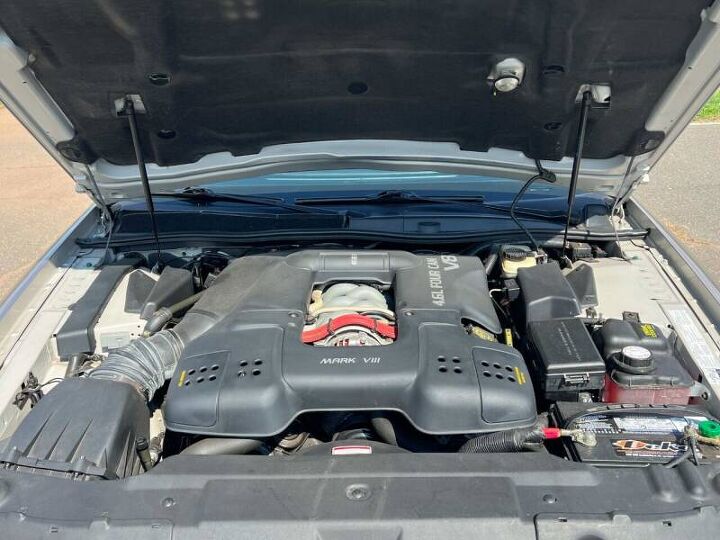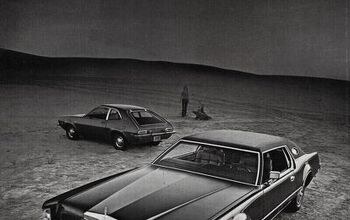Rare Rides Icons: The Lincoln Mark Series Cars, Feeling Continental (Part XLIII)

Ford spent a lot of money and a lot of time on the development of the MN12 platform. An intentional move on the company’s part, the plan was to catch a more elevated customer than those persuaded by the Fox body trio: Ford Thunderbird, Mercury Cougar, and Lincoln Mark VII. In particular, BMW was on the mind of all domestic manufacturers in the Eighties as yuppies pursued status and Ultimate Driving Machine pleasure. Ford attempted to deliver the same experience for less money with its MN12 coupes and derivative FN10; a lightly reworked MN12 chassis used exclusively on the new Mark VIII.
Though it was technically a “separate” platform, the new Mark VIII shared its 113-inch wheelbase with the Thunderbird and Cougar. That was a notable increase over the 108.5-inch measurement of the Mark VII. Other dimensions of the Mark VIII were larger in all directions, a stark contrast to the extreme downsizing implemented on Mark VI, a measure pushed further by the tidy proportions of the Mark VII.
Mark VIII spanned 206.9 inches in length, compared to 202.8” on the outgoing Mark VII. Overall width increased notably, from 70.9” in Mark VII to 74.6 inches on Mark VIII. The more aerodynamic, organic shape of the Mark VIII meant overall height was slightly lower than before at 53.6 inches, over 54.2” for the Mark VII.
Although the Mark VIII was larger than its predecessor, through the use of lighter materials like aluminum it weighed about the same. The Mark VII was 3,748 pounds, and Mark VIII was 3,757 pounds. Worth a quick comparison, the equivalent Thunderbird weighed 3,536 pounds with a V6 engine or 3,725 with the V8. The Cougar was roughly the same depending upon trim level.
One of the most important differences between the Thunderbird, Cougar, and Mark VIII was the latter’s exclusive V8 engine. For the first time ever, a Mark would debut with an engine not offered in other Ford or Lincoln products. Let’s take a quick dive into the world of the Four-Cam V8 that you’d know as InTech.
Part of Ford’s Modular engine family, the new mill shared its 4.6-liter displacement with the company’s standard V8, but was much more technologically advanced. The first four-valve development of the Modular family, the new engine employed dual overhead cams (DOHC). With an aluminum engine block, the V8 used a split port design with two intake ports per cylinder, as well as variable runner length intake manifolds.
All examples of the engine made in 1999 or earlier had blocks cast in Italy, by Teksid S.p.A, a subsidiary of Fiat. Perhaps that bit of detail on the all-American iron was left out of the marketing materials. At the Mark VIII’s debut, the engine was named simply “Four-Cam V8,” but the branding changed to InTech in 1995. The engine was the only one used by the Mark VIII but was exclusive to that model for only 1993 and 1994. By 1995 when InTech naming arrived, the engine spread to the front-drive Lincoln Continental sedan.
The following year InTech made its way into the SVE trim of the Thunderbird and the Mustang SVT Cobra. In 2003 the InTech appeared in its only SUV usage, as the motivator of the new and doomed Lincoln Aviator. Mercury made use of InTech that year, as the engine saw its only Panther platform use in the short-lived Boomer bait Mercury Marauder. The Aviator would be Ford’s last official usage of the InTech engine line when it bowed out in 2005, but the V8 found a home in several other vehicles from smaller manufacturers.
Tiny British firm Marcos used the InTech between 1997 and 1999 as it slowly assembled the Mantis and Mantis GT; the latter version added a supercharger for 506 horsepower. Panoz also used the engine in the AIV roadster between 1997 and 1999, and in the more popular (and ugly) Esperante from 2000 to 2009.
Even more exotic use arrived with the Qvale Mangusta in 2000, the coupe that was originally to herald the return of deTomaso. British maker MG used the engine for three years on the crazy X-Power SV, on sale from 2003 to 2005. Further British usage included the Invicta S1, a badly made sports luxury coupe offered between 2004 and 2012. The S1 was the last vehicle in production anywhere to use an InTech engine.
Perhaps the most exclusive (and powerful) implementation of an InTech was in Koenigsegg’s early vehicles. Proving what performance the engine was capable of, a supercharged version was used in the CC8S of 2003 with an output of 646 horsepower. The company followed up with the CCR of 2004-2006, where another supercharger was added and power jumped to 806 horses and 679 lb-ft of torque.
At its debut in Mark VIII, the Four-Cam engine produced 280 horsepower at 5,500 RPM, and an impressive 280 lb-ft of torque. The powerful engine was attached to the current four-speed version of the AOD automatic used across the Ford company portfolio. With such an advanced engine, premium fuel (91 octane or higher) was recommended for the best performance.
Mark VIII was the first Mark available with dual front airbags, and had four-wheel disc brakes with ABS as standard (optional on Mark VII). The four-wheel independent suspension included a short-long arm design, as well as front and rear stabilizer bars. As in the Mark VII, an electronically controlled air suspension system was standard equipment.
A notable advancement in the Mark VIII’s suspension was programming to lower the ride height slightly at high speeds, which assisted fuel economy via improved aerodynamics. A fairly complex system, it relied on many sensors and solenoids to control the airbags at each corner. For those of you who can read it, enjoy this circuit schematic of the suspension and steering control module.
Lighting was still an important bragging point in the automotive world, and the Mark VIII set some firsts just as the Mark VII had before it. With flush wrap-around headlamps and a rear-lighted heckblende, the Mark became the first domestic vehicle to implement HiD lamps in 1995. When it was facelifted in 1997, the new rear clip sported a much larger heckblende illuminated with neon. Other festive lighting added at that time included puddle lamps and LED signals in the side mirror glass.
New lighting aside, there were many other changes to the Mark VIII’s exterior styling as it debuted in its final and most modern guise. Getting to that finalized styling point was a long, difficult road for Lincoln. Exterior appearances are up next time.
[Images: seller, Ford]
Become a TTAC insider. Get the latest news, features, TTAC takes, and everything else that gets to the truth about cars first by subscribing to our newsletter.

Interested in lots of cars and their various historical contexts. Started writing articles for TTAC in late 2016, when my first posts were QOTDs. From there I started a few new series like Rare Rides, Buy/Drive/Burn, Abandoned History, and most recently Rare Rides Icons. Operating from a home base in Cincinnati, Ohio, a relative auto journalist dead zone. Many of my articles are prompted by something I'll see on social media that sparks my interest and causes me to research. Finding articles and information from the early days of the internet and beyond that covers the little details lost to time: trim packages, color and wheel choices, interior fabrics. Beyond those, I'm fascinated by automotive industry experiments, both failures and successes. Lately I've taken an interest in AI, and generating "what if" type images for car models long dead. Reincarnating a modern Toyota Paseo, Lincoln Mark IX, or Isuzu Trooper through a text prompt is fun. Fun to post them on Twitter too, and watch people overreact. To that end, the social media I use most is Twitter, @CoreyLewis86. I also contribute pieces for Forbes Wheels and Forbes Home.
More by Corey Lewis
Latest Car Reviews
Read moreLatest Product Reviews
Read moreRecent Comments
- SPPPP I suppose I am afraid of autonomous cars in a certain sense. I prefer to drive myself when I go places. If I ride as a passenger in another driver's car, I can see if that person looks alert and fit for purpose. If that person seems likely to crash, I can intervene, and attempt to bring them back to attention. If there is no human driver, there will probably be no warning signs of an impending crash.But this is less significant than the over-arching fear of humans using autonomous driving as a tool to disempower and devalue other humans. As each generation "can't be trusted" with more and more things, we seem to be turning more passive and infantile. I fear that it will weaken our society and make it more prone to exploitation from within, and/or conquest from the outside.
- JMII Based on the human drivers I encounter everyday I'll happily take my chances with a computer at the wheel.The highway driver assist system on my Santa Cruz is great, it can self drive perfectly in about 90% of situations. However that other 10% requires you to be in control and make decisions. I feel this is the problem with an AI driving a car, there are times when due to road construction, weather conditions or other drivers when only a human will know what to do.
- Hari Your route home sounds like the perfect stretch for a car like the Alfa Romeo Giulia. Its renowned handling and dynamic performance make it an ideal match for those curves. For enthusiasts or potential owners interested in understanding all the capabilities of the Giulia 2017, the owner’s manual is an invaluable resource. Check it out here: https://chatwithmanuals.com/automobiles/2017-alfa-romeo-giulia-owners-manual/. Our AI-powered chat makes navigating the manual simple, helping you quickly find specific details about the car's features and specs. Perfect for making the most out of those driving moments and truly understanding your vehicle!
- Dale I'd consider the RAV4 if the Prime were on the table as paying for gas is for suckers. Otherwise, we have a couple of Mazdas and they are swell. I've driven older versions of both and the CX-5 is a nicer place to live.
- Haran Spot-on review of the Mercedes-AMG GT’s price adjustments and new features! For those intrigued by the all-wheel drive and enhanced features of the latest model, you can delve deeper with the complete operator's manual available here: https://chatwithmanuals.com/automobiles/mercedes-amg-gt-operators-manual-edition-c2020/. It’s a fantastic resource for understanding all the specs and new additions without getting bogged down by the complexity typically associated with car manuals. Chat with the manual using AI to quickly find exactly what you need to know about this sporty beast. Perfect for those who appreciate detailed insights on their luxury investments!








































Comments
Join the conversation
This series is epic, but I now fear you'll never get to the gigantic Falcon/Dart/Nova comparison.
Up next is a comparison of all the cars Tassos and EBFlex have puffed each other's peters in. And you thought this series was long.